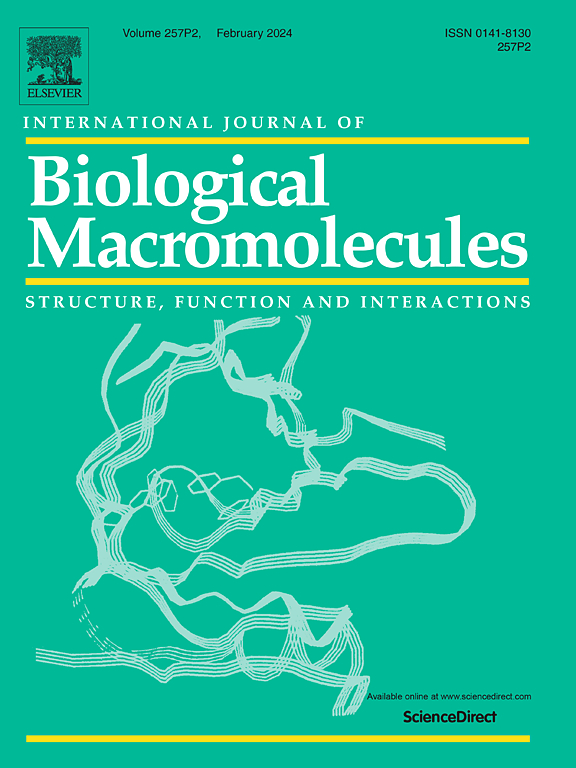Cellulose nanocrystals (CNCs) with different degrees of amination to enhance tolerance to Fe (III) and enhance oil displacement performance
IF 7.7
1区 化学
Q1 BIOCHEMISTRY & MOLECULAR BIOLOGY
International Journal of Biological Macromolecules
Pub Date : 2024-11-04
DOI:10.1016/j.ijbiomac.2024.137260
引用次数: 0
Abstract
Cellulose nanocrystals (CNCs) have been widely concerned in enhanced oil recovery (EOR) due to their abundant resources, small size and easy modification. In crude oil extraction, Fe (III) is increasingly produced. However, CNCs are very sensitive to Fe (III) and easy to aggregate, which brings obstacles to the application of CNCs. In order to improve the tolerance of CNCs to Fe (III), the surface of CNCs was modified with Aminopropyltrimethoxysilane (APTMS), N-[3-Trimethoxysilyl)propyl]ethylenediamine (TMPED) and N-[3-(trimeth-oxysilyl)propyl]diethylenetriamine (TMPDET), respectively. The products were named CNC-APTMS, CNC-TMPED and CNC-TMPDET. The N content in CNC-APTMS, CNC-TMPED and CNC-TMPDET are 1.36 wt%, 2.03 wt% and 2.17 wt%, respectively. The adsorption amount of Fe (III) by CNCs, CNC-APTMS, CNC-TMPED and CNC-TMPDETDT are ∼155 mg/g, ∼ 13 mg/g, ∼ 29 mg/g and ∼ 18 mg/g, respectively. This indicates that compared to CNCs, the modified CNCs improve significantly the tolerance to Fe (III). Moreover, compared to CNCs, in the presence of Fe (III), there is less remaining oil in the glass model after modified CNCs dispersion flooding. The improvement of tolerance to Fe (III) and the excellent oil displacement performance of the modified CNCs in the presence of Fe (III) make them the potential green oil displacement agents.
不同胺化程度的纤维素纳米晶体 (CNC) 可增强对铁(III)的耐受性并提高油的置换性能
纤维素纳米晶体(CNCs)因其资源丰富、体积小、易于改性等特点,在提高石油采收率(EOR)方面受到广泛关注。在原油开采过程中,Fe (III) 的产生量越来越多。但 CNC 对铁(III)非常敏感且易聚集,这给 CNC 的应用带来了障碍。为了提高氯化萘对铁(III)的耐受性,分别用氨基丙基三甲氧基硅烷(APTMS)、N-[3-三甲氧基硅基丙基]乙二胺(TMPED)和 N-[3-(三甲氧基硅基)丙基]二乙烯三胺(TMPDET)对氯化萘表面进行改性。产品分别命名为 CNC-APTMS、CNC-TMPED 和 CNC-TMPDET。CNC-APTMS、CNC-TMPED 和 CNC-TMPDET 中的氮含量分别为 1.36 wt%、2.03 wt% 和 2.17 wt%。CNCs、CNC-APTMS、CNC-TMPED 和 CNC-TMPDETDT 对铁(III)的吸附量分别为 155 mg/g、13 mg/g、29 mg/g 和 18 mg/g。这表明,与氯化萘相比,改性氯化萘显著提高了对铁(III)的耐受性。此外,与氯化萘相比,在存在铁(III)的情况下,改性氯化萘分散浸泡后玻璃模型中残留的油更少。改性氯化萘对铁(III)耐受性的提高以及在铁(III)存在下优异的油置换性能使其成为潜在的绿色油置换剂。
本文章由计算机程序翻译,如有差异,请以英文原文为准。
求助全文
约1分钟内获得全文
求助全文
来源期刊
CiteScore
13.70
自引率
9.80%
发文量
2728
审稿时长
64 days
期刊介绍:
The International Journal of Biological Macromolecules is a well-established international journal dedicated to research on the chemical and biological aspects of natural macromolecules. Focusing on proteins, macromolecular carbohydrates, glycoproteins, proteoglycans, lignins, biological poly-acids, and nucleic acids, the journal presents the latest findings in molecular structure, properties, biological activities, interactions, modifications, and functional properties. Papers must offer new and novel insights, encompassing related model systems, structural conformational studies, theoretical developments, and analytical techniques. Each paper is required to primarily focus on at least one named biological macromolecule, reflected in the title, abstract, and text.

 求助内容:
求助内容: 应助结果提醒方式:
应助结果提醒方式:


